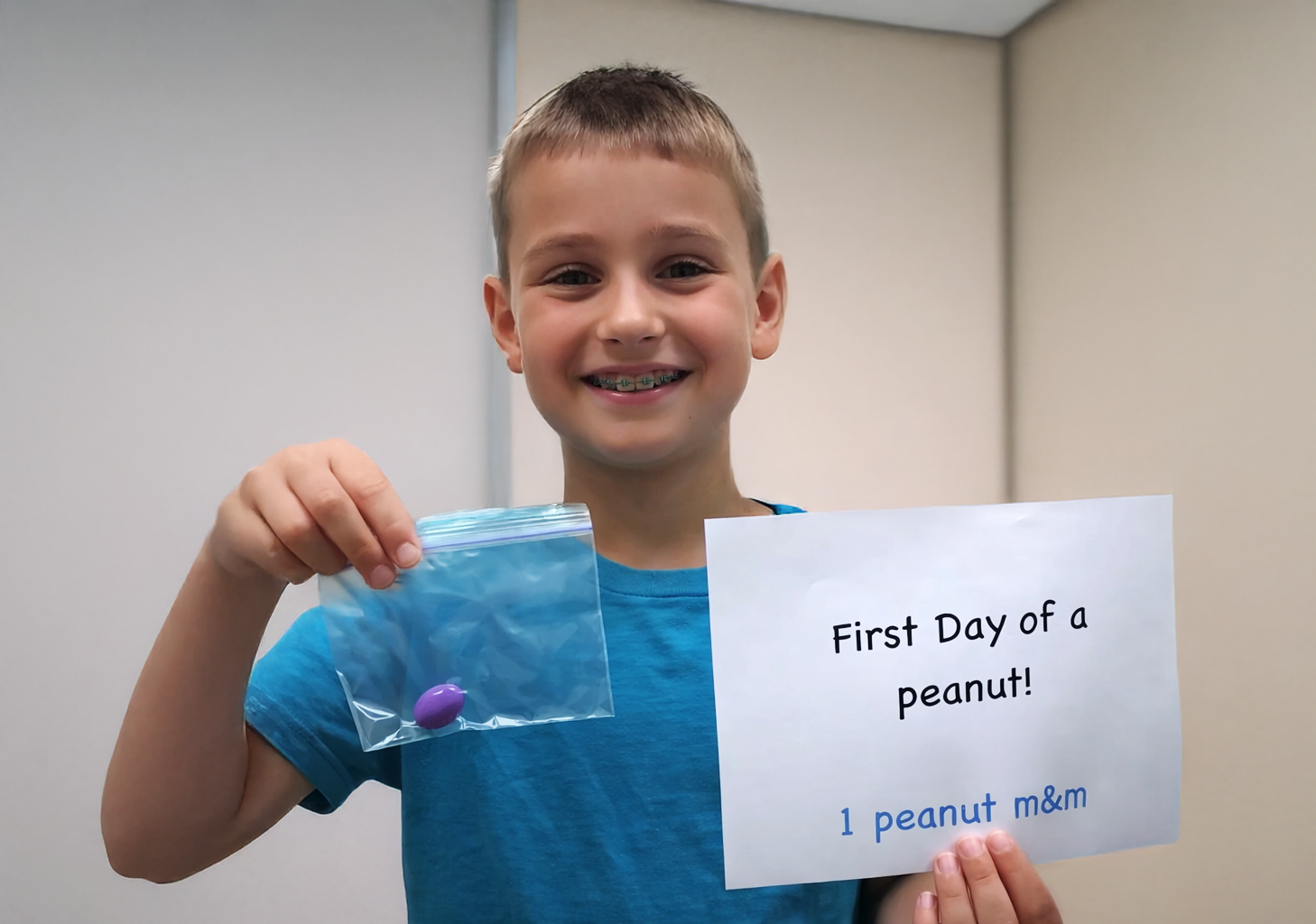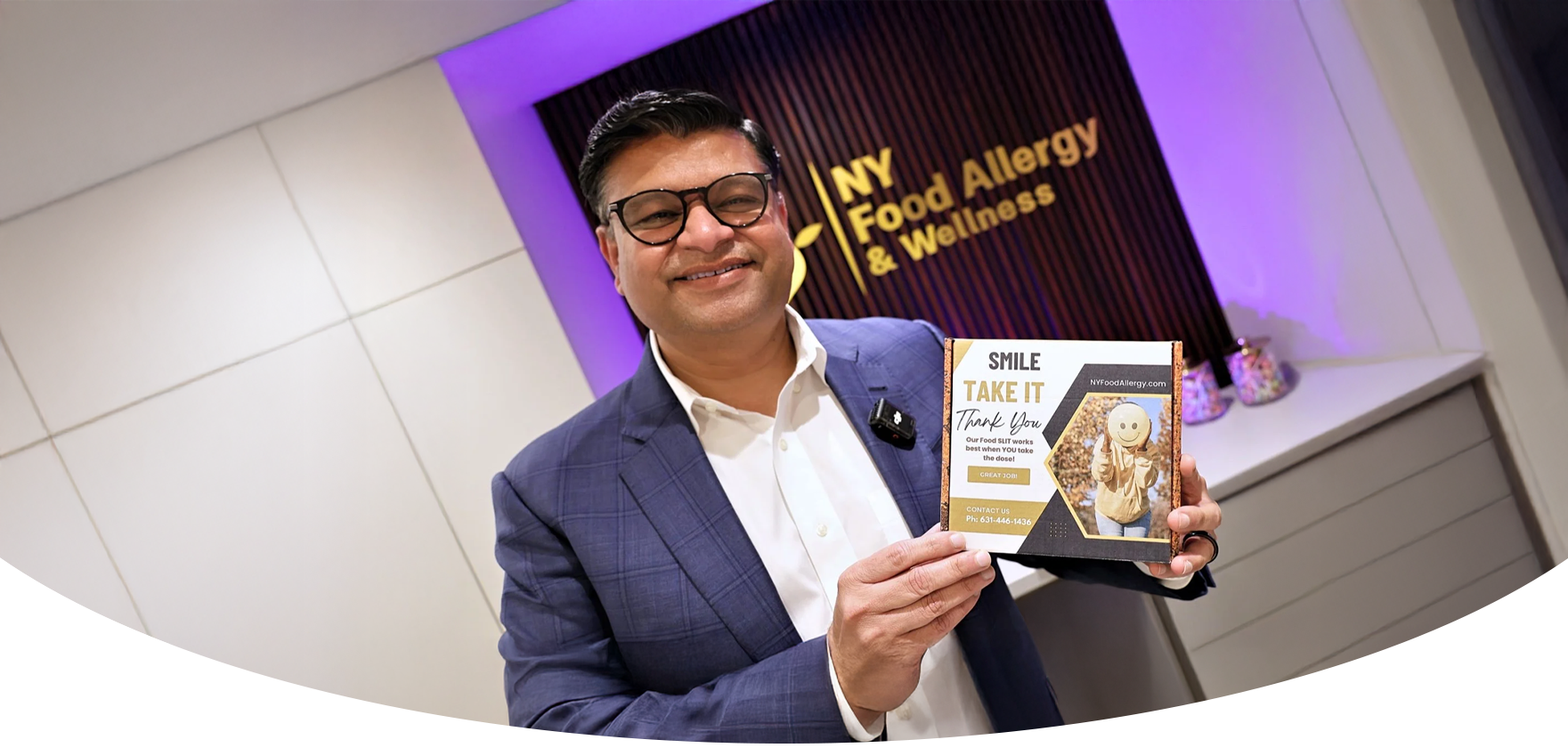Understanding
Oral Immunotherapy
Understanding oral immunotherapy starts here: a detailed look at how this cutting-edge treatment can desensitize you to food allergens, like peanuts, milk, eggs, wheat, tree-nuts, sesame, etc., and what that journey involves. From the breakthrough science behind it to the practical steps of managing daily doses, learn the essentials without the medical jargon.
FOOD ALLERGY TREATMENT:
Oral Immunotherapy (OIT)
Where active desensitization begins. Using Oral Immunotherapy (OIT), Dr. Shah carefully introduces tiny amounts of allergen in a controlled, stepwise fashion to build tolerance and reduce the risk of severe reactions.
OIT is a medical treatment for food allergies where the patient consumes small amounts of the allergenic food, with the amount gradually increased over time.
OIT Process: OIT typically begins with extremely low doses of the allergenic food, given under close medical supervision. The dose is increased in small, scheduled steps until a maintenance level is reached.
OIT Objective: The goal of OIT is to desensitize the patient to the allergen, reducing the risk and severity of reactions from accidental exposures and, for some patients, helping them reach regular, confident intake of the food.
OIT Foods Treated: OIT is commonly used for allergies to peanuts, milk, eggs, and tree nuts. At NY Food Allergy & Wellness, OIT plans are customized to the patient’s age, history, and goals.
Oral Immunotherapy (OIT) for Food Allergies: Overview, Phases, and Risks
What is Oral Immunotherapy (OIT)?
Oral Immunotherapy (OIT) is a treatment for food allergies where patients are gradually exposed to increasing amounts of an allergen, aiming to build tolerance and reduce allergic reactions. While effective for various food allergies, so far the FDA has approved OIT for peanut allergies.
The OIT process: three phases
The OIT process involves three phases: initial dose escalation, build-up, and maintenance, with the intention of increasing the body’s tolerance to allergens and decreasing the risk of severe allergic reactions. This applies to all foods, including the peanut OIT.
Potential risks and side effects
OIT can have significant benefits but also carries risks and potential side effects, such as allergic reactions, anaphylaxis risk, and possibility of eosinophilic esophagitis (EoE). The OIT helps patients reach the state of desensitization and tolerance over time.
Outcomes can vary by patient, and the plan should be guided by an experienced allergist.
What is Oral Immunotherapy (OIT)?
Oral Immunotherapy (OIT) is a treatment for food allergies where patients are gradually exposed to increasing amounts of an allergen, aiming to build tolerance and reduce allergic reactions. While effective for various food allergies, so far the FDA has approved OIT for peanut allergies.
The OIT process: three phases
The OIT process involves three phases: initial dose escalation, build-up, and maintenance, with the intention of increasing the body’s tolerance to allergens and decreasing the risk of severe allergic reactions. This applies to all foods, including the peanut OIT.
Potential risks and side effects
OIT can have significant benefits but also carries risks and potential side effects, such as allergic reactions, anaphylaxis risk, and possibility of eosinophilic esophagitis (EoE). The OIT helps patients reach the state of desensitization and tolerance over time.
Outcomes can vary by patient, and the plan should be guided by an experienced allergist.
How Oral Immunotherapy (OIT) Works for Food Allergies
What Oral Immunotherapy (OIT) is
Oral Immunotherapy (OIT) is an approach for addressing food allergies. It involves gradually introducing small amounts of the allergen into a patient’s daily diet in order to desensitize them and increase their tolerance. This process, closely monitored by medical professionals, aims to reduce the severity of allergic reactions.
How dosing works during treatment sessions
During OIT treatment sessions, patients are given increasingly larger doses of the allergen. This carefully controlled method helps individuals build up resistance.
Why OIT may be recommended
OIT is often considered an option for managing food allergies, with the goal of reducing reaction severity over time. Individual results and risks can vary, so treatment decisions should be made with an experienced allergist.
What Oral Immunotherapy (OIT) is
Oral Immunotherapy (OIT) is an approach for addressing food allergies. It involves gradually introducing small amounts of the allergen into a patient’s daily diet in order to desensitize them and increase their tolerance. This process, closely monitored by medical professionals, aims to reduce the severity of allergic reactions.
How dosing works during treatment sessions
During OIT treatment sessions, patients are given increasingly larger doses of the allergen. This carefully controlled method helps individuals build up resistance.
Why OIT may be recommended
OIT is often considered an option for managing food allergies, with the goal of reducing reaction severity over time. Individual results and risks can vary, so treatment decisions should be made with an experienced allergist.
The Science Behind Oral Immunotherapy (OIT)
How desensitization works
The science behind oral immunotherapy (OIT) involves gradually exposing the body to small amounts of an allergen, which may help reduce allergic reactions over time. This process, known as desensitization, is intended to strengthen the body’s ability to tolerate food allergens.
FDA-approved peanut OIT and ongoing progress
We have been providing OIT for peanuts and other common foods for many years. The FDA has approved products for peanut OIT, and additional options may become available over time as research evolves.
Types of food allergies treated with OIT
OIT can be used for a wide range of food allergies, including peanuts, tree nuts, milk, eggs, wheat, sesame, soy, and more. In some cases, OIT may be considered for infants and young children with confirmed allergies.
For patients managing multiple food allergies, our team works closely with families to decide which allergen(s) to address first. In certain cases, multiple foods can be combined within the same cycle of OIT based on clinical planning and monitoring.
How desensitization works
The science behind oral immunotherapy (OIT) involves gradually exposing the body to small amounts of an allergen, which may help reduce allergic reactions over time. This process, known as desensitization, is intended to strengthen the body’s ability to tolerate food allergens.
FDA-approved peanut OIT and ongoing progress
We have been providing OIT for peanuts and other common foods for many years. The FDA has approved products for peanut OIT, and additional options may become available over time as research evolves.
Types of food allergies treated with OIT
OIT can be used for a wide range of food allergies, including peanuts, tree nuts, milk, eggs, wheat, sesame, soy, and more. In some cases, OIT may be considered for infants and young children with confirmed allergies.
For patients managing multiple food allergies, our team works closely with families to decide which allergen(s) to address first. In certain cases, multiple foods can be combined within the same cycle of OIT based on clinical planning and monitoring.
The Journey From Peanut Allergy Toward Increased Tolerance (OIT)
Starting day appointment
The approach to achieving tolerance for peanut and other food allergies through oral immunotherapy (OIT) is a meticulous and well-planned process. In the first starting day appointment, which typically takes 4-6 hours, the allergic patient will receive gradual doses of increasing amounts of food protein.
Up-dosing phase
This method focuses on gradually building up exposure in order to enhance tolerance levels over time.
Maintenance phase
The child must consume daily measured amounts of food protein during this up dosing phase until reaching a maintenance level where they continue consuming an allotted amount consistently or as directed by our team in order to help sustain their progress.
Starting day appointment
The approach to achieving tolerance for peanut and other food allergies through oral immunotherapy (OIT) is a meticulous and well-planned process. In the first starting day appointment, which typically takes 4-6 hours, the allergic patient will receive gradual doses of increasing amounts of food protein.
Up-dosing phase
This method focuses on gradually building up exposure in order to enhance tolerance levels over time.
Maintenance phase
The child must consume daily measured amounts of food protein during this up dosing phase until reaching a maintenance level where they continue consuming an allotted amount consistently or as directed by our team in order to help sustain their progress.
Preparing for Oral Immunotherapy: Tips for Daily Dosing Success
Set up a routine before starting OIT
Proper preparation is important when considering the potential benefits and risks of oral immunotherapy (OIT). This includes understanding the treatment flow, planning how dosing fits into daily life, and making practical routine adjustments that support consistency.
Tools to help families follow the dosing regimen
To support day-to-day adherence, many families use simple systems like a written schedule, calendar reminders, or a clearly organized dosing station that stays in the same place at home. Keeping dosing supplies and instructions easy to access can reduce missed or delayed doses.
After-dose habits that may reduce discomfort
Some protocols recommend calm activities for a period after dosing. Eating prior to an OIT dose may help reduce gastrointestinal symptoms for some patients. We invest significant time in education with each family so expectations, safety steps, and daily routines are clear before and during OIT.
Set up a routine before starting OIT
Proper preparation is important when considering the potential benefits and risks of oral immunotherapy (OIT). This includes understanding the treatment flow, planning how dosing fits into daily life, and making practical routine adjustments that support consistency.
Tools to help families follow the dosing regimen
To support day-to-day adherence, many families use simple systems like a written schedule, calendar reminders, or a clearly organized dosing station that stays in the same place at home. Keeping dosing supplies and instructions easy to access can reduce missed or delayed doses.
After-dose habits that may reduce discomfort
Some protocols recommend calm activities for a period after dosing. Eating prior to an OIT dose may help reduce gastrointestinal symptoms for some patients. We invest significant time in education with each family so expectations, safety steps, and daily routines are clear before and during OIT.
Ready to Speak With Our Care Team?
GET IN TOUCH
Fill out the form below to begin your journey towards Food Allergy Freedom. Our care team will respond shortly!
Managing Multiple Food Allergies With Oral Immunotherapy (OIT)
Multi-food OIT overview
OIT has the ability to manage multiple food allergies at once, not just a single one. This is made possible by creating personalized treatment plans for each specific allergen.
Single vs multi-food OIT planning
From milk and eggs to peanuts, tree nuts, wheat, soy, sesame and baked goods containing these ingredients, OIT can be applied for various types of food allergies. There are many factors that we consider before deciding single vs. multi-food OIT and foods that can be combined. This gets designed based on safety, risks, and the commitment level of the family.
Combining treatments for different food allergens
When dealing with multiple food allergies, it is important to have a strategic plan for incorporating treatments for each allergen. This may involve adjusting dosages and timelines according to the individual patient’s needs and progress. It is possible to distribute doses evenly among four to six different food allergens.
Maintaining open communication with our team throughout the treatment process is crucial in order to promptly address any concerns that may arise. By doing so, patients can ensure their safety during treatment and improve their ability to manage multiple food allergies.
Multi-food OIT overview
OIT has the ability to manage multiple food allergies at once, not just a single one. This is made possible by creating personalized treatment plans for each specific allergen.
Single vs multi-food OIT planning
From milk and eggs to peanuts, tree nuts, wheat, soy, sesame and baked goods containing these ingredients, OIT can be applied for various types of food allergies. There are many factors that we consider before deciding single vs. multi-food OIT and foods that can be combined. This gets designed based on safety, risks, and the commitment level of the family.
Combining treatments for different food allergens
When dealing with multiple food allergies, it is important to have a strategic plan for incorporating treatments for each allergen. This may involve adjusting dosages and timelines according to the individual patient’s needs and progress. It is possible to distribute doses evenly among four to six different food allergens.
Maintaining open communication with our team throughout the treatment process is crucial in order to promptly address any concerns that may arise. By doing so, patients can ensure their safety during treatment and improve their ability to manage multiple food allergies.
Severe Multi-Food Allergy Success Story
Weighing the Pros and Cons of Oral Immunotherapy (OIT)
Benefits and limitations of OIT
While there are benefits to utilizing OIT, it is important to weigh both strengths and limitations. Many protocols focus on reaching a consistent maintenance dose over time, often within a span of about six to twelve months, depending on the food, the dosing plan, and the individual patient.
Published reports on desensitization rates vary, and outcomes can differ based on patient factors and the specific protocol used. The best approach is individualized and guided by careful medical oversight and ongoing monitoring.
Success rates, effectiveness, and practical outcomes
A closer look at effectiveness focuses on what desensitization can change in everyday life. For some children and families, building a higher threshold may reduce anxiety around accidental exposure and can make travel and dining out feel more manageable.
In some treatment plans, dosing goals may increase substantially over time, for example from very small amounts of food protein to much larger amounts. Reaching higher thresholds may reduce the risk of severe reactions from accidental exposure, but the degree of protection is individual and not guaranteed.
Potential side effects and complications of food OIT
OIT can also carry risks and side effects, including allergic reactions that may require treatment. In some published reports, the need for epinephrine during OIT has been described in a minority of patients, with estimates that can fall in the single-digit to low double-digit percent range depending on protocol and population.
Another concern is eosinophilic esophagitis (EoE), which has been reported in a small percentage of individuals undergoing OIT in some studies. Other possible adverse effects can include abdominal pain, nausea, and vomiting. Because of these risks, candidacy, dosing, and follow-up should be guided by an experienced allergy team.
Benefits and limitations of OIT
While there are benefits to utilizing OIT, it is important to weigh both strengths and limitations. Many protocols focus on reaching a consistent maintenance dose over time, often within a span of about six to twelve months, depending on the food, the dosing plan, and the individual patient.
Published reports on desensitization rates vary, and outcomes can differ based on patient factors and the specific protocol used. The best approach is individualized and guided by careful medical oversight and ongoing monitoring.
Success rates, effectiveness, and practical outcomes
A closer look at effectiveness focuses on what desensitization can change in everyday life. For some children and families, building a higher threshold may reduce anxiety around accidental exposure and can make travel and dining out feel more manageable.
In some treatment plans, dosing goals may increase substantially over time, for example from very small amounts of food protein to much larger amounts. Reaching higher thresholds may reduce the risk of severe reactions from accidental exposure, but the degree of protection is individual and not guaranteed.
Potential side effects and complications of food OIT
OIT can also carry risks and side effects, including allergic reactions that may require treatment. In some published reports, the need for epinephrine during OIT has been described in a minority of patients, with estimates that can fall in the single-digit to low double-digit percent range depending on protocol and population.
Another concern is eosinophilic esophagitis (EoE), which has been reported in a small percentage of individuals undergoing OIT in some studies. Other possible adverse effects can include abdominal pain, nausea, and vomiting. Because of these risks, candidacy, dosing, and follow-up should be guided by an experienced allergy team.
Managing Daily Routines During Oral Immunotherapy Dosing
Activity restrictions around OIT dosing
It can be important to adjust routines and plan around dosing. Some patients are advised to avoid activities that raise body temperature or heart rate for a set window before and after dosing, including intense exercise and hot showers.
Meals and common precautions
Many protocols recommend taking doses with, or after, a meal. In some cases, a meal with complex carbohydrates is recommended prior to up-dosing. Certain medications, including ibuprofen, may be restricted around dosing for some patients depending on the plan provided by the treating team.
Vigilance and ongoing communication with NYFA
Vigilance plays an important role in monitoring for possible side effects. Open communication with our NYFA team helps address concerns early and supports safe, consistent daily dosing. These strategies can make OIT easier to manage within everyday life.
Activity restrictions around OIT dosing
It can be important to adjust routines and plan around dosing. Some patients are advised to avoid activities that raise body temperature or heart rate for a set window before and after dosing, including intense exercise and hot showers.
Meals and common precautions
Many protocols recommend taking doses with, or after, a meal. In some cases, a meal with complex carbohydrates is recommended prior to up-dosing. Certain medications, including ibuprofen, may be restricted around dosing for some patients depending on the plan provided by the treating team.
Vigilance and ongoing communication with NYFA
Vigilance plays an important role in monitoring for possible side effects. Open communication with our NYFA team helps address concerns early and supports safe, consistent daily dosing. These strategies can make OIT easier to manage within everyday life.
Frequently Asked Questions
Individuals with food allergies who are dedicated to undergoing oral immunotherapy (OIT) can be considered suitable candidates, regardless of the severity of their allergy.
Those who experience severe and potentially life-threatening reactions to certain foods would see the greatest benefits from OIT.
One form of oral immunotherapy is used in the maintenance phase for treating a peanut allergy. This involves consuming a precise amount of peanuts daily to gradually build up tolerance.
It is crucial to follow our guidance throughout this process, as stopping or altering the treatment can lead to increased risk of reactions and potentially reverse progress made against the allergy.
The FDA has approved a peanut product for oral immunotherapy treatment, reducing the impact of allergic reactions in individuals who have a medically confirmed diagnosis of peanut allergy.
It is nice to have FDA approved products to do the process of food OIT, but it is not necessary to start and complete OIT for other foods.
Oral immunotherapy, also known as OIT, is a gradual increase in the amount of an allergenic food given to someone with allergies. The goal is to build up their tolerance and decrease the chance of having a reaction.
This method helps individuals become less sensitive or get desensitized to specific foods they are allergic to.
OIT has the capability to address multiple food allergies concurrently through individualized treatment strategies for each specific allergen.
This means that all of a person’s known food allergies can be targeted and managed individually or simultaneously with customized plans.
Oral immunotherapy must be done by food allergy experts, like the NYFA team with resources to plan and execute OIT with safety and best outcomes.
You can learn more about the Oral Food Challenge, as well as all of the food allergy treatment options by watching success stories on our YouTube channels. NY Food Allergy & Wellness and Center4Asthma&Allergy.
What our patients are saying...
About Dr. Atul Shah: Testimonials
Get Started Today!
Visit NYFA’s Manhattan Office
NY Food Allergy & Wellness is located on the Upper East Side at 110 East 60th St., Suite 708, New York, NY 10022. Serving all of Manhattan, the NYC metro area, New Jersey, Connecticut, and patients nationwide, as well as international visitors.



















